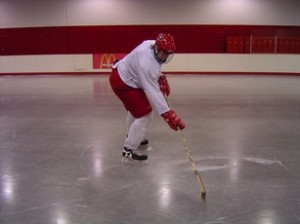
Hockey players as well as fans use a portion of their brain not usually associated with language development when they discuss the sport. That area is not activated, however, among non-fans when asked about the sport.
Being an athlete or merely a fan improves language skills when it comes to discussing their sport because parts of the brain usually involved in playing sports are instead used to understand sport language, new research at the University of Chicago shows.
The research was conducted on hockey players, fans, and people who’d never seen or played the game. It shows, for the first time, that a region of the brain usually associated with planning and controlling actions is activated when players and fans listen to conversations about their sport. The brain boost helps athletes and fans understanding of information about their sport, even though at the time when people are listening to this sport language they have no intention to act.
The study shows that the brain may be more flexible in adulthood than previously thought. “We show that non-language related activities, such as playing or watching a sport, enhance one’s ability to understand language about their sport precisely because brain areas normally used to act become highly involved in language understanding,” said Sian Beilock, Associate Professor in Psychology at the University of Chicago. She is lead author of the paper, “Sports Experience Enhances the Neural Processing of Action Language,” to be published Tuesday, September 2 in the on-line issue of the Proceedings of the National Academy of Sciences.
“Experience playing and watching sports has enduring effects on language understanding by changing the neural networks that support comprehension to incorporate areas active in performing sports skills,” she said.
The research could have greater implications for learning. It shows that engaging in an activity taps into brain networks not normally associated with language, which improves the understanding of language related to that activity, Beilock added.
For the study, researchers asked 12 professional and intercollegiate hockey players, eight fans and nine individuals who had never watched a game to listen to sentences about hockey players, such as shooting, making saves and being engaged in the game. They also listened to sentences about everyday activities, such as ringing doorbells and pushing brooms across the floor. While the subjects listened to the sentences, their brains were scanned using functioning Magnetic Resonance Imaging (fMRI), which allows one to infer the areas of the brain most active during language listening.
After hearing the sentences in the fMRI scanner, subjects performed a battery of tests designed to gauge their comprehension of those sentences.
Although most subjects understood the language about everyday activities, hockey players and fans were substantially better than novices at understanding hockey-related language.
Brain imaging revealed that when hockey players and fans listen to language about hockey, they show activity in the brain regions usually used to plan and select well-learned physical actions. The increased activity in motor areas of the brain helps hockey players and fans to better understanding hockey language. The results show that playing sports, or even just watching, builds a stronger understanding of language, Beilock said.
Joining Beilock in this research were Howard Nusbaum, Professor of Psychology at the University; Steven Small, Professor of Neurology and Psychology at the University; and Beilock’s Ph.D. students Ian Lyons and Andrew Mattarella-Micke.
Source: University of Chicago  via Newswise
